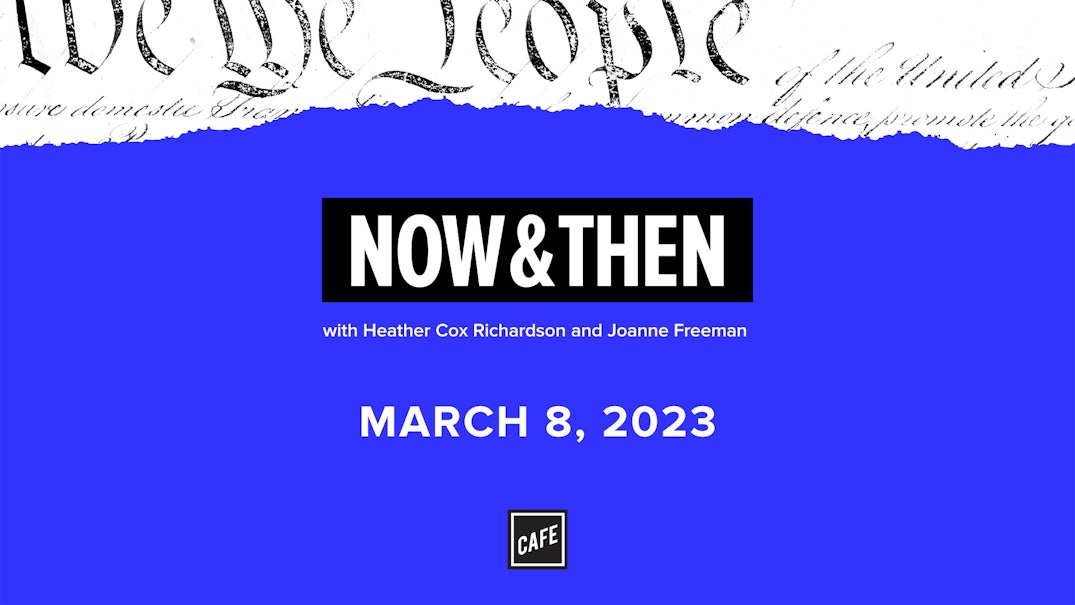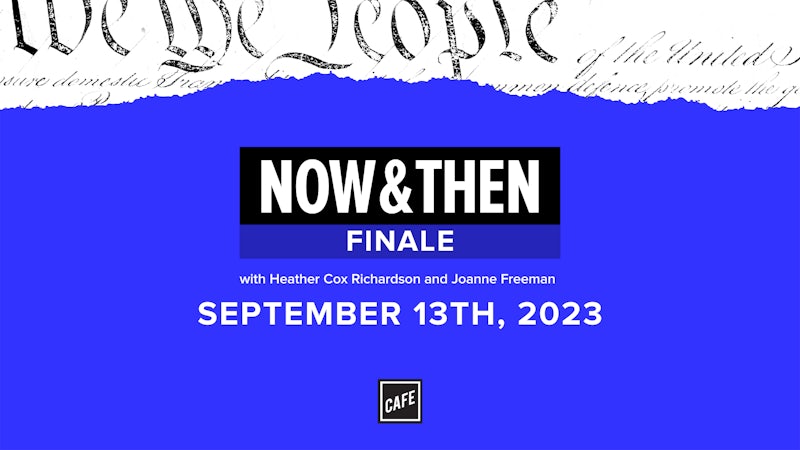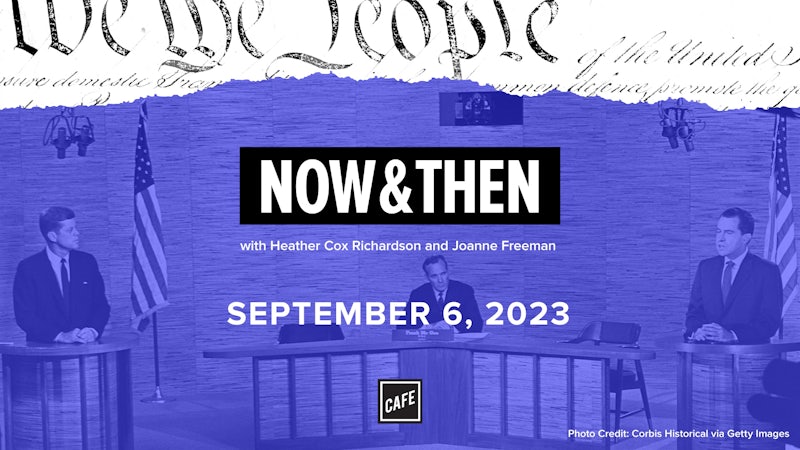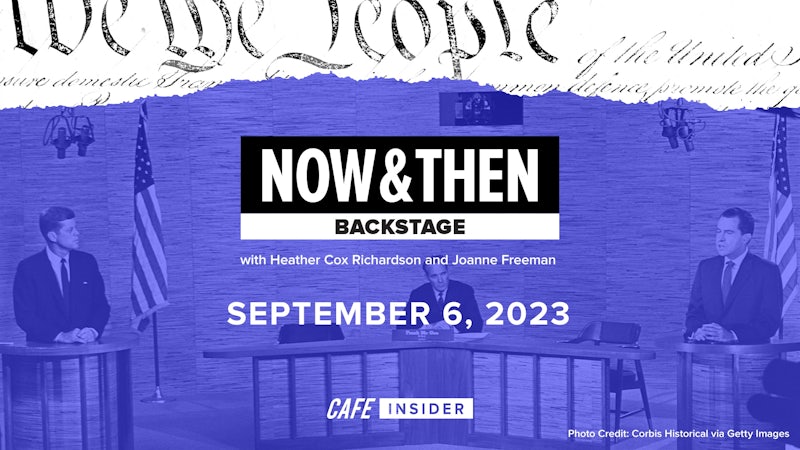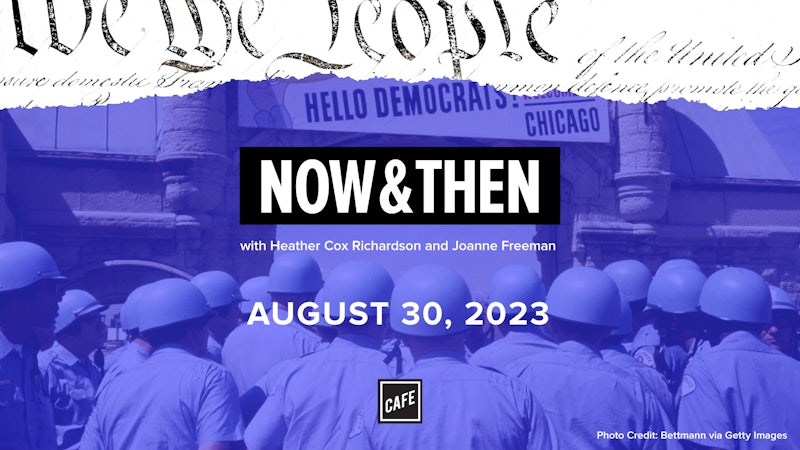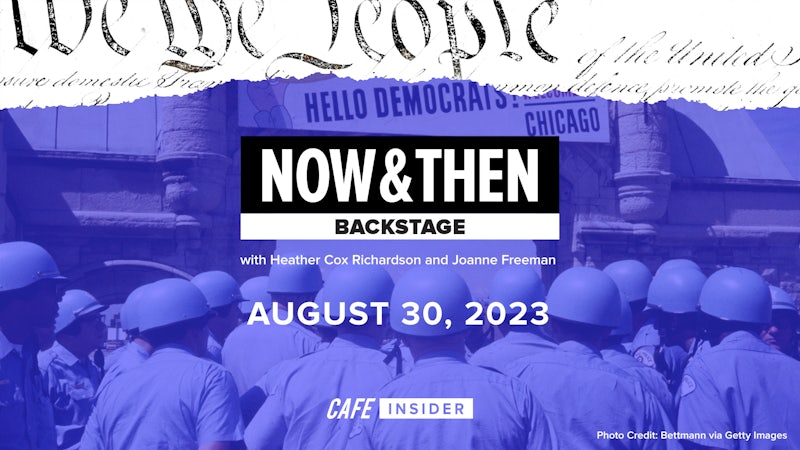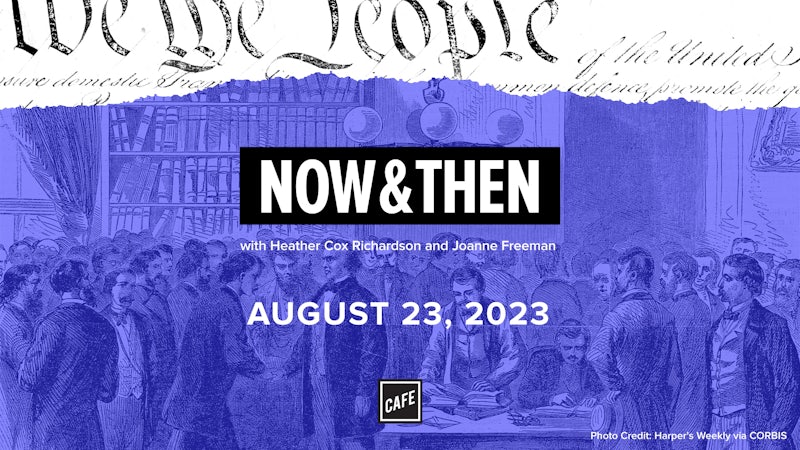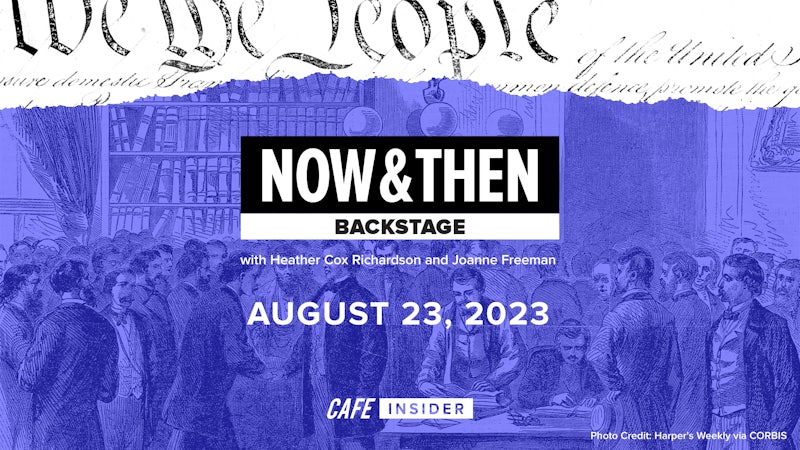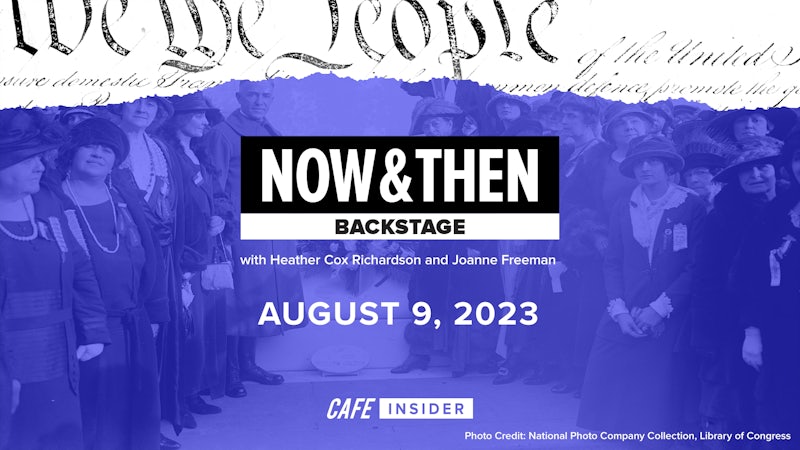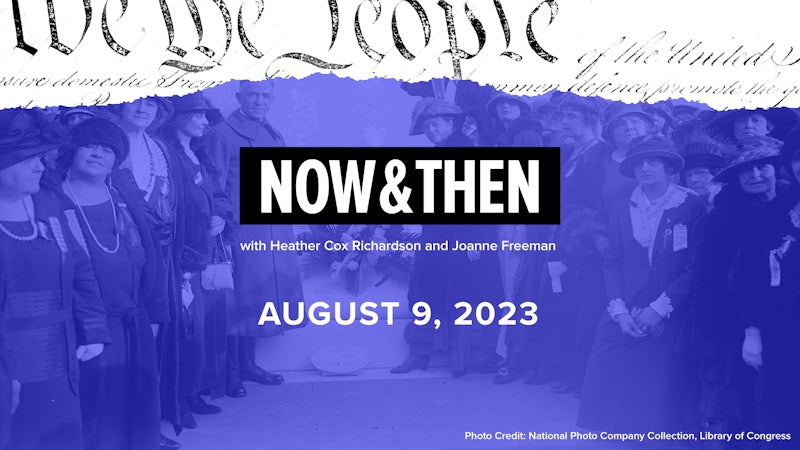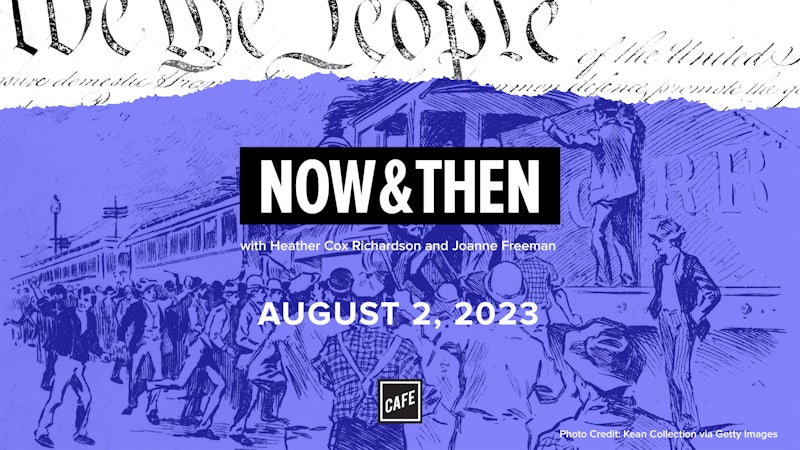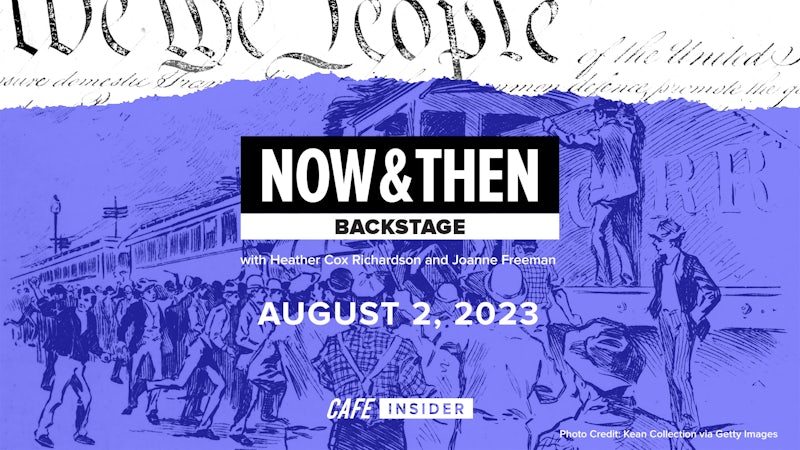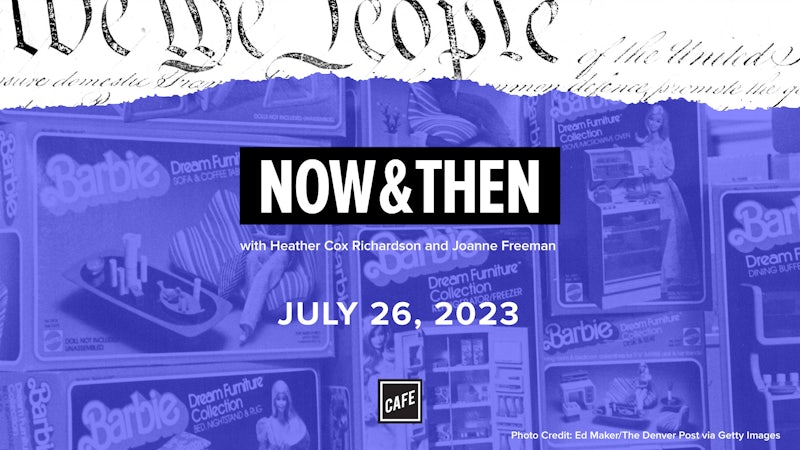Heather Cox Richardson:
From Cafe and the Vox Media Podcast Network, this is Now & Then. I’m Heather Cox Richardson.
Joanne Freeman:
And I’m Joanne Freeman. Today’s topic was sparked by an event that happened in February in East Palestine, Ohio in which a train derailed and released toxic chemicals over this town and it has obviously been a big deal because they were very toxic chemicals. That has sparked us to want to talk today about how environmental disasters and pollution and actually just garbage have been dealt with in the past, and more importantly, how people have fought over, who’s responsible for where they go. But before we plunge in there, let’s talk a little bit about what happened in Ohio because that’s actually going to frame really well what we’re going to be talking about today.
Now on February 3rd, a Norfolk Southern Freight train carrying toxic chemicals derailed in the eastern part of the state. It ignited a fire that covered East Palestine in smoke and it had a lot of toxic materials on it, but perhaps the most dangerous was vinyl chloride which is a toxic flammable gas. So a number of things happened immediately.
Heather Cox Richardson:
The first thing that happened was that the federal government began to respond as was normal for what was a train accident, a derailment, which are actually fairly common, that did not cause injury or loss of life immediately. So the Environmental Protection Agency was on the scene by about 2:00 the following morning. The derailment was about 9:00 on the 3rd. They were there by 2:00 on the 4th. And the National Transportation Safety Board, which is an independent federal agency, not part of the transportation department, which is responsible for overseeing train accidents, was also on the scene almost immediately. So there was an immediate federal response to what was happening there in East Palestine.
Joanne Freeman:
On a state level, on February 5th, both Ohio Governor Mike DeWine and Pennsylvania Governor Josh Shapiro instituted an evacuation order on both sides of the Ohio-Pennsylvania border. And the next day, Norfolk Southern conducted a controlled release and burn off of some of the chemical cargo, hoping to avoid an explosion that would cause even more damage. Now, the evacuation order was lifted on February 8th, but since that point, residents who have returned to the area have been reporting a number of ailments like rashes, nausea, trouble breathing and not surprisingly, particularly given the times in which we live, this issue has become highly politicized.
Heather Cox Richardson:
So Republican critics of the Biden administration have criticized the federal government for not in their opinions doing enough about what happened at East Palestine and especially putting pressure on Transportation Secretary Pete Buttigieg for not having the Department of Transportation there immediately. But of course, the Department of Transportation is responsible not for immediate cleanup or accidents. They actually were there working with the National Transportation Safety Board, which as I say is independent so it can investigate without political oversight.
The Department of Transportation is really about whether or not any regulations were broken and they did in fact have their people on the ground and continue to have their people on the ground for that. The Democrats, on the other hand, have looked at the complaints on the part of the Republicans who hit very hard and very fast and said, “Wait a minute here. What really was going on with this derailment was that the Trump administration overturned regulations that had been put in place by the Obama administration to require trains that are carrying hazardous wastes to have much more effective breaks and to classify trains more widely as carrying hazardous materials.”
And what’s really interesting about both of these perspectives is that the National Transportation Safety Board has come forward and said, “Stop it, everybody. The whole point of doing an investigation is to figure out what happened here and this is not helpful.” So they’ve actually been fairly heated about it. So over this event here, our political perspectives and the reality that we need to wait and learn more about it, but also as Joanne said, a really important question about who is responsible for environmental disasters. But also that question of who is responsible is really fundamentally a question about who owns our environment and who owns our land and to whom does that environment owe a responsibility and that is an incredibly interesting question.
Joanne Freeman:
I’ll add one little piece to it, which is not only who owns that kind of space, but also who listens? When are people willing to acknowledge that people in power and when are they not? So it is. It is a big question about communities, about cities, about space, about a sense of an urban we, about civic society. It touches on enormous issues and it all starts with the simple fact of garbage or pollution presenting a problem that has to be dealt with. And that’s the point that sparks these kinds of really big questions.
Heather Cox Richardson:
So there’s no point really in starting this question, Joanne, until we get to the 1880s, right? Because until then, everybody lives in towns and it’s just cleaning up crap is just not a problem.
Joanne Freeman:
There isn’t any crap. It’s a crapless period of American history. So we’re going to look for just a little bit here at New York City in the beginning of the 19th century because New York City, I mean many cities had a notorious problem of garbage and trash and other nastiness on their streets, New York City was famous for it. The streets apparently were so packed with filth of various sorts, manure and everything else, that although some of the streets in New York actually were paved, New Yorkers didn’t actually know that because they didn’t ever see the paving. They were packed with garbage and lifeness supposedly every day in New York City in that period in the early 19th century. 10,000 horses each deposited up to 40 pounds of manure in a day. So this is giving you a little hint of New York City streets.
Heather Cox Richardson:
I feel not so bad about not cleaning my house.
Joanne Freeman:
I didn’t think of that, Heather, but thank you. I actually really, really need that. So imagine those streets and then imagine that they were filled with pigs. Before we plunge in here about specifics, I should say that a lot of the information in this section comes from Portland State University History Professor Catherine McNeur’s book, Taming Manhattan: Environmental Battles in the Antebellum City. So one of the things she talks about in her book is all of these pigs that were in New York City roaming around on the street. She said that one 1820 estimate suggested that there were 20,000 hogs living in the settled parts of Manhattan, about one for every five humans.
Now, it’s important to note most of those pigs were owned by New York City farmers, chimney sweeps and other working-class people. And the pigs, although they were running around in the streets, not necessarily looking or sounding particularly wonderful, they were eating garbage. So they were actually providing a service and they were a main source of food and goods at the time. So they’re not running around being useless. They actually are performing services. The question is where are they running and who gets to say whether they should or shouldn’t be there?
Heather Cox Richardson:
And just to clarify, this is not Wilbur sitting there looking cute and lovely. These are domestic pigs that are operating on their own and pigs are real scavengers.
Joanne Freeman:
They eat anything, right?
Heather Cox Richardson:
Yeah.
Joanne Freeman:
That’s part of why they were good, but that’s also nasty.
Heather Cox Richardson:
They also are able to protect themselves, so they can turn very aggressive and they certainly are not really concerned about getting along well with the humans around whom they live. So when you think pigs, don’t think it’s a cute little 15-pound Wilbur. These are large, dirty and potentially aggressive animals that both feed people and clean up the garbage, but also are not necessarily something you want to deal with when you need to walk down the street.
Joanne Freeman:
So given all of that, it, in a sense, is not surprising that early in the 19th century, some upper class New Yorkers and people in local government wanted to forcibly remove the pigs, which are largely owned by people who are not in the upper classes from city streets. And you end up having an extended battle between the elite and the pig owners that goes on for quite some time about should the pigs be there, who gets to decide that, and what does it mean if they are or aren’t allowed to stay? So for example, in 1812, there was a meeting of the Common Council, which is a precursor to what today would be the New York City Council. And someone on the Common Council complained about what it was like to be in the street with these pigs.
He said, “Every description of filth is there deposited and the swine, by rooting up the ground and wallowing there in the mire make the passage to the battery from Broadway not only very unsightly but very offensive.”
Heather Cox Richardson:
So you got the Common Council working for the rich guys, I would assume, saying, “We got to get rid of these pigs.” That’s not an unreasonable request. The pigs are ginormously nasty.
Joanne Freeman:
And running around freely. So there’s this back and forth over the pigs. So for example, 1816, Bank of New York Director Elijah Hammond organizes a petition among 200 powerful city elders for the removal of the pigs. Pigs are defended by a black chimney sweep and pig owner named Adam Marshall. Couple of years later, you have a petition by working-class New Yorkers against the removal of pigs and they say in their petition, “Pigs are our best scavengers as they instantly devour all fish, guts, garbage and awful of every kind,” which tells you exactly what those streets look like, “which is suffered to remain during the summer months would be very offensive and might very probably be injurious to the health of the inhabitants.”
Heather Cox Richardson:
Can I just say on this front? I have a neighbor who keeps a couple of pigs, and when we still had shrimp season in Maine, which we don’t any longer, he would get the remains of the shrimp plants dumped for the pigs to eat. And it smelled so bad that within like a half a mile of his place, you would literally start holding your breath. So when we’re talking about these things being nasty, they were probably really nasty.
Joanne Freeman:
It’s a good point, is that the 18th and much of the 19th century are ages when there were a lot of extreme odors floating around, right? These are not sanitized ages by any means. So if in that period they’re noting that the smell is horrific, it’s got to be really, really outstandingly bad. I found this amusing only because it feeds on the eternal New York joke about making fun of New Jersey, but it flips it on its head, that supposedly people were nervous about eating for, I suppose logical reasons, the swine that were feeding off of the garbage in the streets, that they tended to get their more expensive pig meat from farms in New Jersey or on Long Island that were far away from the New York City streets since they were worried about what would happen if they ate these scavenger pigs of New York.
So here’s the New York Evening Post in 1819. It’s suggesting to people that, “New Yorkers with sensitive stomachs maybe should not be eating Manhattan pork. When Manhattan pigs, these scavenger pigs become diseased from high feeding on dead cats and the vermin in the gutters or any other cause, they soon find their way to our butcher stalls. Knowing this may be the case, and if in fact it is not, many people of my acquaintance whose stomachs are rather squeamish would soon taste a broiled rat as the finest looking griskin or roaster that can be brought to the table.” So you can’t blame them.
So after, as I’m suggesting here, years of going back and forth on this between the people who own the pigs who are of the lower classes and the upper class people who want them to go away, in 1821, there’s a anti-pig mayor in office named Steven Allen and he pushes a law that says, “Any pig that’s unattended should be rounded up, sent to the almshouse where it would be cooked and served for dinner.” And these poor almshouse commissioners end up having to round up pigs for this purpose.
Heather Cox Richardson:
Well, and of course, the rounding up and the taking of these pigs is the loss of hundreds of pounds of meat. I’m talking about them as nuisances, but this is literally the government confiscating what your family could eat or exchange for things to eat for a very long time.
Joanne Freeman:
Income for your family, in one way or another, just taking it away. So not surprisingly, there were a number of riots that erupted over this problem with the pigs. There was one in 1826, another in 1830, another in 1832. And again and again and again, the working classes came together to defend really what they considered to be their property, their rights to own this property and their rights for the property, the pigs to be doing what they do in the streets, eating garbage and then ultimately providing meat either for families or for others. So now this problem goes on for a while and we know for example, that there’s a problem with these pigs as late as 1842 because in his book, American Notes, British writer Charles Dickens, was a little tickled by these city scavengers, although when you read his notes on America, he’s a little tickled and also a little grossed out basically by what he sees.
He has a really amusing take on tobacco spitting as well, but here’s what he says about the pigs in the streets in 1842, “They are the city scavengers, the pigs. Ugly brutes they are, having for the most part scanty brown backs like the lids of old horsehair trunks spotted with wholesome black blotches. They have long gaunt legs too and such peaked snouts that if one of them could be persuaded to sit for his profile, nobody would recognize it for a pig’s likeness. They are never attended upon or fed or driven or caught, but are thrown upon their own resources in early life and become preternaturally knowing in consequence.”
Heather Cox Richardson:
You can receive the Time Machine articles through the free Cafe brief email. Sign up at cafe.com/brief. So it wasn’t just New York that had a problem with pigs. In fact, one of the things that early settlers complained about in Chicago is the fact that it’s basically just a bunch of dirt streets full of pigs rolling the streets. And the next thing we wanted to highlight was not the pigs themselves in the streets, but what happens in Chicago at the turn of the next century to pollution, having to do with the meat-packing industry that rises in Chicago. When we first started talking about doing an environmental show, this is the first information that came to my mind was from a book called Property Rules, wonderful pun there, Political Economy in Chicago 1833 to 1872 by Robin Einhorn.
I found this book extraordinarily illuminating and we’ll walk through the pieces of it. But what Einhorn sets out in that book is this really central question, “Who owns a city? Is it the people who literally own it, who own the property? Do they get to rule, property rules or is it the people who actually live in it?” And that is a question that they’re really hashing out in the late 19th century and one that, of course, has enormous implications right through to the present. So what really was an issue in Chicago beginning after the Civil War is what to do with the nastiness that is left over from the meat-packing industry. So at this point, we’re not really talking about the chemicals, we’ll be talking about in the 20th century, but all the pieces and filth that is left from meat packing.
So in Chicago’s Bridgeport District, which was in the meat-packing district, there was a marshy area called hilly slough into which the crap from the factories drained. It was just as foul as you would have expected to. One alderman said it was one of the violinist and most dangerous kind, which any civilized person had to contend with. So we’re dealing with industrial waste here on a scale that people previously could not have imagined.
Joanne Freeman:
Here’s where I have my extra material for you, Heather. I found it in a book that has anecdotes from attorneys.
Heather Cox Richardson:
From hilly slough.
Joanne Freeman:
From hilly slough. Well, this actually does involve hilly slough. It was an attorney who was defending a person whose husband apparently fell into the slough.
Heather Cox Richardson:
Oh, this is not going to go in a good way.
Joanne Freeman:
It’s not going to go in a good place. And drowned her was poisoned or something and apparently fell in on one side of the slough and was found on the other side of the slough. And somehow or other, the defendants were arguing he didn’t fall in where they said he fell in and so somehow the charges were different. And this lawyer, his name is Oliver H. Horton apparently brought in a chemistry expert to explain how a body would be affected by the gases that are in the slough and could float across a not very fluid slough and get to the other side, but the argument wasn’t going very well. So the next day he came in and he produced what is described as a small wide-mouthed black bottle.
Heather Cox Richardson:
Oh, this is just going in such a bad direction.
Joanne Freeman:
It is going in a bad direction. And I will say these kinds of accounts, these stories from the bench and bar are always exaggerated, but this guy points to a specific trial with a specific judge there ruling it. So there has to be some truth here. This chemistry expert said, “Gentlemen, your questions yesterday denoted a strong anxiety on your part to ascertain as most germane to the issues of this case, the exact nature of the odors arising from the pungent, the quiescent body known as hilly slough. I am glad to say that I have here, as you may nasally, discern the very strongest kind of evidence on the point. In this bottle, I have the sublimated quintessence of the aroma that floats over hilly slough.”
He pulled the stopper as he spoke and a powerful odor immediately filled the courtroom. There was a sudden general gasping of breaths and grasping of noses, then a great trampling of feet and clattering of falling chairs as lawyers, jurymen, witnesses and spectators made in a panic for doors and windows. The court, it was Judge Porter, was heard to shout something about contempt of court before he shoved his head out of the window. And then it’s clerked up again and they continue on with this trial, but what this particular lawyer did end this account by saying is that people ever after refer to that particular courtroom as somehow or other having the stink of hilly slough in it. Certainly, that gives you a sense, even if it’s exaggerated of the nastiness that this represented.
Heather Cox Richardson:
The meat-packing and real estate elite in Chicago argued that the way to handle this issue would be to dredge the slough to make it navigable for ships that could bring goods to and from the meat-packing plants from the Chicago River. Meanwhile, people in the area were very aware of the economic concerns underneath the standoff and they said that they needed actually a cleaning plan, not just a plan to improve shipping. So in 1872, six years after the beginning of the discussions to either dredge or clean the slough, Bridgeport residents issued a petition complaining about the delay and blaming the meat-packing plant owners for the terrible conditions of the slough.
They said, “A few wealthy individuals, owning property, boarding on said slough, have made strenuous efforts to have the same dredged, actuated only by motives of their own private aggrandizement. To open and dredge said slough would be to perpetuate all the nuisances that present complained and add more to the number as also to entail a vast expense on the city for the building and maintaining bridges over the same without any public consideration therefore.” Chicago’s Board of Health kept saying that the city authorities should enforce antidumping regulations while the meat packers insisted that they should have a dredging of the slough in order to open it as a navigable canal to the Chicago River.
The fight over who owned the land in Chicago really came to a focal point over a fight over hilly slough and whether it was the responsibility of the meat packers to stop dumping in this area that was really just crushing the people who lived by it or whether it was the responsibility of the municipality to clean it up or finally whether or not that was okay to have the meat packers who brought so much money and so many jobs to the area treat it however they wished.
Joanne Freeman:
The question here is not only who has the right to control this public space, but also how is that decision being made according to the clout and money that the different parties have. So in the case of the pigs, we had working-class people organizing, but you can see how from a top-down point of view, if manufacturers and a city believe that great capitalism is taking place, and yes, there is this trash often going in working-class areas or lower-class areas of the city that this is going to seem like a problem that won’t necessarily be addressed with great speed. It’s going to be seen as a problem that’s the result of capitalism.
Heather Cox Richardson:
And maybe, as Einhorn puts it, maybe this is the way society is supposed to work. Maybe because those meat packers are doing so much for the city, it’s fine for the city either to have to suffer through what they have done or to pay to clean up their messes, which I think is a really interesting idea. Einhorn says, “What if hilly slough was not considered an urban failure? What if Chicago’s handling of hilly slough was considered successful by 19th century standards that were very different from our own? What if the city was supposed to subsidize meat packers and lard renderers in their dumping and ignore rambling petitions from irrelevant people who happen to live nearby? What if, as many late 19th century municipal reformers contended, city governments were business corporations that should be operated chiefly to benefit their stockholders, the property owners who had invested in urban real estate?”
I love that concept, not that I’m advocating that concept, but it helps you think about the issues of waste disposal in a way that absolutely made sense to industrialists in the 19th century, “Hey, listen, we’re bringing all these steel manufacturers and meat-packing plants and all these jobs and all this growth and all this prosperity to this region. Okay, yeah. So you got to break a few eggs to make the omelet, but that’s the job of the municipality to clean up because we are over here making stuff for the community. You guys can clean it up. That’s just your job.” That is a really interesting and I think ultimately deeply flawed concept, but it does help to you to get your heads around the idea of where we’ve ended up so often with these environmental issues.
Joanne Freeman:
Well, and it’s useful in context of what we’re talking about today and just more generally. You may not agree with the viewpoint of certain people in this kind of an argument, but it’s certainly important to understand how one side or another is justifying it other than or beyond just, “We have power,” “No, we have power.”
Heather Cox Richardson:
It is worth mentioning, of course, that the meat packers are totally making bank under this system and the people whose environments are being polluted are not. So there is a huge amount of money at stake here, but that idea of who owns the city I think is a really interesting one and it’s also going to be in Chicago that there’s going to be a significant pushback against the meat packers and people like them. And I love this side of it as much or perhaps more and that is that, “In Chicago, thanks to people like Jane Addams and Ellen Gate-Starr who were reformers in what we now know as a settlement house movement, they get involved in this situation by looking at the excesses of industrial capitalism and saying, ‘We have destroyed the idea of the common good.'”
So in 1889, Addams and Starr found Hull House on the west side of Chicago in the midst of an immigrant neighborhood with the idea of bringing back community and social responsibility and the idea of a shared experience between immigrants and reformers like themselves. Addams is quickly involved with the lives of children in this region for a number of reasons and she quickly is very concerned about children around Hull House eating garbage. And she says, in 20 years at Hull House, which is her memoir she wrote in 1910, “The children of our neighborhood 20 years ago played their games in and around huge garbage boxes. They were the first objects that the toddling child learned to climb. Their bulk afforded a barricade and their contents provided missiles in all the battles of the older boys. And finally, they became the seats upon which absorbed lovers held enchanted converse. We are obliged to remember that all children eat everything which they find and that odors have a curious and intimate power of entwining themselves into our tenderest memories.”
She also was very concerned about the enormous numbers of flies that landed around the garbage and were in the garbage and then in and out of homes and was very concerned about the fact that their ward had very high death rates for children. And she saw a connection between all the garbage and the death rates and she also was very aware that the machine politics in Chicago meant that the people who were in charge of collecting the garbage and inspecting the garbage weren’t showing up for their jobs.
Joanne Freeman:
Well, precisely, that city government did not have laws, strong laws at least to keep people and industries from dumping waste where they were dumping it. They didn’t want to drive industries out of the city by enforcing these restrictions. And very often, sanitary inspection was given to political cronies of [inaudible 00:28:42]. So there isn’t a system in place really to enforce whatever little there is already in place. And you can see here how Addams, again if you’re thinking about a city as a shared space, the people who she’s championing for are not only poorer people in society, but also immigrant society.
And part of her concern is that people are coming here as immigrants and aren’t even aware of what they’re entitled to in this kind of space, what kind of living they should have access to as opposed to what it is that they’re being stuck with where they’re living in these cities. So again, Addams, she is an upper class reformer, but she’s speaking for these people who are part of this shared space and don’t necessarily have someone speaking for them.
Heather Cox Richardson:
So I love this. She makes garbage a big issue and Jane Addams was a striking looking woman. She had very, very large blue eyes. Everybody commented on them. She looks calm and she looks still because she’s got these giant eyes. She’s actually a total fire breather, but finally, she makes such a big stink about the garbage that in 1895.
Joanne Freeman:
No pun intended.
Heather Cox Richardson:
I did that on purpose. I’ve actually been salting words like crap and all that throughout this whole episode. The Chicago mayor, George Swift, appoints her as Chicago’s first female garbage inspector and her political opposition is outraged. So the salary for that was a thousand bucks a year, and that’s a lot of money and that really infuriates a number of politicians who wanted that money for their own people. It was not supposed to be a sinecure, that is you were supposed to, if you took this job, get up at 6:00 in the morning and watch the garbagemen, follow the wagons, making them pick up the stuff that fell off the wagons. You were really supposed to be out there doing their jobs, but the previous men had not done that. They’d basically taken the salary and done their political stuff.
She did it. She did it and then she filed suit against landlords who didn’t provide garbage cans. She gets Mayor Swift to appoint eight additional crews in her ward to help with garbage collection. Finally, after a number of months on the job, she transferred the role to her assistant, a woman named Amanda Johnson, who was in the position until 1898. And at that point, an alderman from the ward was so sick of these two women and their increasing power, he changed the role of garbage inspector to being both garbage inspector and road inspector and you had to be a man in order to hold that position. So essentially he got rid of the position, so he could get rid of Hull House.
Joanne Freeman:
To get rid of these women.
Heather Cox Richardson:
Yeah …
Joanne Freeman:
Yes, indeed.
Heather Cox Richardson:
… but Addams did something interesting. She reflected then on what it had meant to have Johnson and herself in that role and pointed to mortality rates. She said, “The careful inspection, combined with other causes, brought about a great improvement in the cleanliness and comfort of the neighborhood. And one happy day, when the death rate of our ward was found to have dropped from third to seventh in the list of city wards and was so reported to our Women’s Club, the applause which followed recorded the genuine sense of participation in the result and a public spirit which had made good.”
Joanne Freeman:
I want to point out a couple things there because that’s a really remarkable quote. Number one, what she has done is highlighted this issue and made it an issue that people recognize. Number two, it is rousing a sense of public spirit around the idea of acting on this and working in a way to benefit the people in the city that are being most affected by it. So this is one of those examples when someone works really hard at something and in the end they’re not victorious, but that doesn’t mean they failed. Because what they’re doing or what they have done is pushed something into public debate, made something really evident, given people a sense of their rights and what they’re entitled to.
So regardless of whether they win a legislative battle or whether they lose their jobs, these kinds of actions, particularly by people who are continually being deprived of power, meaning not white men, they have an impact and they have an important impact. And certainly Addams is one of those people.
Heather Cox Richardson:
Well, and after our recent episode where we talked about women who had made huge changes without getting recognized for it, it is not insignificant that Jane Addams and Ellen Gate-Starr are female. There is also though the next step of that and that is that a woman who was allied with Addams, a woman named Mary McDowell, who had worked at Hull House teaching kindergarten, started her own settlement house near the University of Chicago, the University of Chicago Settlement House, and it was in the Union Stockyards, which were part of Chicago’s meat-packing district. The stockyards, just like hilly slough, dumped into both the neighborhood and a body of water, the Bubbly Creek, which was also a marshy tributary of the Chicago River. And it became full of decaying stuff. Sometimes it was solid and then it would give way.
Upton Sinclair actually described it in his meat-packing expose, The Jungle in 1906 saying, “Chickens walk about on it and many times an unwary stranger has started to stroll across and vanished temporarily.” Oh, anyway, she, McDowell, gives a letter to Theodore Roosevelt, President Theodore Roosevelt in 1906, complaining how bad conditions are in that neighborhood. He forwards the letter onto the House Agriculture Committee and that led to the first federal investigation of the Stockyards. She goes to Europe for a while to study sanitary engineering, and when she comes back, she is part of the 1913 Chicago Commission on Waste where she’s a researcher and recognized that she needed to encourage scientific experts to come have a role in Chicago city government and to get rid of the partisanship and political aims that had, until then, determined whether or not the city should be cleaned up.
She said, “The important lesson learned by this excursion into the field of city sanitation showed that the municipal government needs trained scientific experts to run the bureau, that there is a great waste of the taxpayer’s money in playing into the hands of a national party that has no interest in the city’s welfare as long as votes are secured for the party machine.”
Joanne Freeman:
Just have to add here before we move on is that Mary McDowell actually became known as the Garbage Lady and the Angel of the Stockyards. And I would say, given all that she achieved, that would’ve been a badge of honor for what she accomplished for what she did.
Heather Cox Richardson:
I like that, Garbage Lady.
Joanne Freeman:
The Garbage Lady, I know, right? That’s got a zing to it.
Heather Cox Richardson:
Yeah, maybe we can be the Garbage Ladies. The political Garbage Ladies.
Joanne Freeman:
The Political Garbage Ladies. Now this example that we just talked about is the early 20th century. The next thing that we want to talk about really reaches a crescendo in the late 1970s, but it starts at the end of the late 19th century. And this has to do with Love Canal, which is a name that many people know. So in 1892, a shadowy entrepreneur named William T. Love, bet you didn’t know that Love Canal was named after someone named William Love, proposed connecting the Upper and Lower Niagara River by digging a seven-mile canal. A year later, the panic of 1893 made that rather ambitious project unfeasible.
So he abandons this canal and he leaves behind a partially dug section that’s 60 feet wide and 3,000 feet long. In 1920, that canal was sold at public auction, and at that point, the city began to allow chemical companies to dump waste into the canal. 20 years later, 1942, the Hooker Chemical Company, which had taken control of the canal and produced chlorine and other chemicals used in manufacturing rubber, began dumping really significant amounts of toxic chemicals into the canal. Now, in the early 1950s, Hooker Chemical Company filled the canal in with dirt and sold the site to the city’s Board of Education for a dollar. And the Hooker Company briefly acknowledged on the de transfer that dangerous chemicals were buried under the site.
And here’s the language, the very vague language, non-alarming language from the grant to the Board of Education, “The grantee herein has been advised by the grantor that the premises above described have been filled in whole or in part to the present grade level thereof with waste products resulting from the manufacturing of chemicals by the grantor at its plant in the city of Niagara Falls, New York and the grantee assumes all risk and liability incident to the use thereof.”
Heather Cox Richardson:
Now, I just want to jump in here for a second and suggest that the new technologies of the early 20th century create this whole new problem, same questions, but the whole new problem like we were talking about before, because we really get the development of the chemical industry and not an understanding necessarily of what that means. So what we’re talking about is the period between the chemical industry taking off through World Wars I and World War II, and yet before we get, Rachel Carson’s Silence Spring in 1962 saying, “Hey, wait a minute. These chemicals are not always great. They can do real harm.”
The whole setup of the book is, “We’ve got all these miracle chemicals that do so many wonderful things, but they’re also potentially extraordinarily deadly.” And to recognize that in now in the 21st century, we’re all pretty much on board with the idea we shouldn’t put everything in our bodies, but there was this period when it was like, “We don’t really know what we’ve got, but oh boy, look at all the cool things you can do.”
Joanne Freeman:
So in 1954, the Niagara Falls Board of Education begins to construct an elementary school on the canal property. The 99th Street School, which has a student population of 400, begins serving the area in 1955. Along with that, private developers soon after began constructing homes in the area. So by 1978, there were about 800 private single family homes and 240 low-income apartments built around the canal. Now, in the mid-1970s, the large underground drums that were holding the chemical waste from Hooker began to disintegrate. And after a particularly rainy 1976, chemicals began seeping out of the ground and into the basements of Love Canal homes.
In June 1978, an area mother named Lois Gibbs became concerned about potential contamination after her five-year-old son, Michael, who was a student at the 99th Street School suddenly began having epileptic seizures. Gibbs, to her credit, goes door to door in her neighborhood and asks her neighbors about their health issues and plots them on a map that suggests clusters of health issues near where reports of chemical leakage occurred. And she spearheads an advocacy group, the Love Canal Homeowners Association, to lobby for a government investigation.
That same month, local journalist, Mike Brown, began publishing articles on the history of Love Canal in The Niagara Falls Gazette and he tied the chemicals to the high rates of migraines and birth defects and sudden childhood illnesses in the area. Now, the County Health commissioner, Dr. Francis Clifford, initially ignored the allegations and he said, “Well, there’s a high rate of cancer among my friends. It doesn’t mean anything.” So there are these maps that are showing, “Wow, there are leaks from Love Canal and then people got all of these illnesses, huh?” and Clifford is saying, “Well, yeah, but I have a lot of friends with cancer too. That’s a cluster. What do these clusters mean?”
Well, the New York State Health Department investigated and found evidence of potential chemical danger, including 20,000 tons of contaminants and high levels of dioxins, which are a group of particularly toxic organic chemical compounds that result from different chemicals mixing together. In August of 1978, New York Governor Hugh Carey began to orchestrate the evacuation of 239 families closest to the canal while President Jimmy Carter declared a federal emergency for the immediate area surrounding the contaminants. But controversy immediately broke out because some people were evacuated and others living around the perimeter of the canal were not necessarily evacuated.
So an October 1978 Buffalo News report captured the frustration of these people who hadn’t been evacuated by interviewing a young father, Raymond Aul, who was denied relocation assistance. And as he gave this interview, his wife holding his three-month-old son stood next to him and Aul says-
Raymond Aul (archival):
Oh, I think it stinks. I feel sold out by the state, by the health department. We give aid to anybody else in the world that needs aid. All I want to do is just get out of my house and I can’t.
Interviewer (archival):
Do you have some definite health problems among your family members?
Raymond Aul (archival):
Yes, we do. We have an infant here that’s three months old, got a congenital defect, just took them out of the hospital an hour ago, and now I’m supposed to move them back into our contaminated house with chloroform in it.
Joanne Freeman:
So eventually, the state and federal government relocated more than 800 families and covered the losses of their homes. We know this incident because Love Canal, it becomes sort of almost a buzzword for this kind of disaster, but it was far from the only environmental waste incident in the late 1970s. There were any number of other incidents where there was toxic waste being dumped, sometimes barrels or drums beginning to disintegrate over time, dumping things that are toxic into the environment and affecting the lives of people who live around those areas.
President Carter centered the Love Canal disaster during January 1980, predicting that a slough of further toxic waste sites would emerge amid the corrosion of older industrial and chemical plants and the growing recognition of the potential health effects that they had. He said, “One of the most important environmental and public health issues facing our nation is the threat caused by the improper disposal of hazardous substances. Accidents like those at Love Canal and Valley of the Drums,” another one of those places where the drums were disintegrating, “have highlighted the inadequacy of the existing laws and inability of governments at all levels to respond quickly and efficiently to these dangerous incidents. In the coming years, there may be thousands of hazardous waste sites which will need attention, the cost of which could be enormous. Clearly, an effective public policy is needed to deal with this situation.”
Heather Cox Richardson:
So Congress actually does try to deal with the effects of places like Love Canal. And in December 1980, Carter signed the Comprehensive Environmental Response Compensation and Liability Act, which most people know is the Superfund Act. And that led to the cleanup of more than 400 toxic sites across the nation under the auspices of the Environmental Protection Agency. And the cost of the cleanups were covered by the companies who created the pollution primarily, although in many cases, taxpayers ended up footing the bill because the company had either dissolved or there was not one clear negligent corporation.
In his memoir in 1982, Keeping Faith, Carter suggested that the Superfund legislation might be as important as any legacy of his presidency. He said, “This new program may prove to be as far-reaching and important as any accomplishment of my administration. The reduction of the threat to America’s health and safety from thousands of toxic waste sites will continue to be an urgent, but bitterly fought issue. Another example for the conflict between the public welfare and the prophets of a few private despoilers of our nation’s environment.”
This then I think brings us back to East Palestine and what happened there and the real central questions of what certainly seemed to be in the years after the passage of the Superfund Law, the return of the idea that we essentially are privatizing profits and socializing risks, if you will. One of the things that people point to in the East Palestine disaster is that railroads have actually been doing phenomenally well financially since the pandemic and have put their money into stock buybacks rather than into safety upgrades or into keeping a sufficient labor force on those sites. And yet here we are in looking at what happened to East Palestine and expecting at least on the part of some Americans, the government, to fix the problems that are there and to pay for the problems that are there.
Joanne Freeman:
So on the one hand, you have the railroad company and whether or not they bear any responsibility here, and last week, there is at least the beginning of talk from someone, a whistleblower from the railroad company, that they had been told by the company not to focus so much time on inspecting railcars because it was slowing down the speed with which things were delivered. I’m sure more of that will come out. Then you have the fact of the government, what responsibility does the federal government have? What responsibility do local governments and state governments have?
And then in the case of our current moment, you have political parties in the mix too, who are using the ambiguities that we’ve been talking about throughout this episode as a way to politicize this moment. “Well, the President should have been there. Someone should have done something more quickly,” although Heather, as you said at the outset, things were happening immediately as they should have. But the fact that this remains a fraught issue where clear lines of responsibility and ownership are not drawn and perhaps can’t be drawn makes this kind of issue, particularly environmental issues, really rife for these kinds of conflicts and disputes for them to be emotional because they involve human life, living in a city, your right to breathe air and live someplace safe and have your children be healthy.
Heather Cox Richardson:
But it’s just so interesting to me that in issues like where we are right now with East Palestine, the impulse is not to go after the company, which is responsible for this and the burning off of the chemicals, which was signed off on by the governor of Ohio and not to go after them, but to say, “The federal government needs to fix what happened to me.” And you see this again and again and again. At the same time, people are saying, “But we don’t want federal regulation and we don’t want federal taxation.” It’s just a really complicated, “Who should …” I have very strong ideas about it, of course. I’m sure everybody does, but, “Who bears the burden when we mess up our community? Who should fix it?”
Joanne Freeman:
“Who should fix it and whose voice matters?” and tied to that a theme that we talk about continually here on Now & Then that is, “How can people make their voice be heard?” when we saw several times in this episode, people being affected by these disasters organizing so that their voice will be heard so that they will have an impact so that they can weigh in these debates, which seem to be leaning towards the people with financial political power. So in a way, a sort of this episode is the power of popular organization and the ways in which it can give people a voice that matters.












